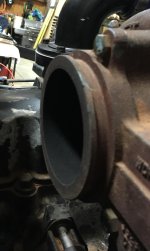I got this from Haldex and it confuses the schidt out of me. I need a translation.
After watching the video, it seems that you are getting a weak and sluggish control signal from the governor. Also, I believe you have some issues with plumbing between the air dryer and the reservoirs. Per FMVSS 121, the service reservoir(s) must be protected against a failure of their source, i.e. a one way check valve or something similar. There is also a requirement that states the reservoir volume on the truck must be able to hold 12 times the volume of the brake chambers. It definitely sounds like one of the check valves that protect one of the reservoir(s) is bad. This is evidence of the pressure gauge in the dash falling when air is constantly leaking out of the purge valve of the dryer. Your specific dryer back feeds the discharge line with wet tank pressure after the purge cycle is engaged by the pressure signal from the governor. The end of the turbo protection valve seals off the inlet port internally in the air dryer to prevent the back charged air in the discharge line from leaking out of the open purge valve. The turbo protection valve basic function is really similar to a double check valve. It gets pushed around by higher air pressure on either side of it. During the building air phase, air coming in from the air compressor is pushing it towards the control port, allowing air to pass by it and flow through the dryer. Once system pressure is reached, the governor sends a system pressure signal to the control port of the dryer, and to the unloader mechanism in the compressor. This causes air to stop being compressed by the compressor and sent to the dryer, lowering the pressure on the inlet side of the turbo protection valve. At the same time, 125 psi should be sent to the opposite end of the turbo protection valve, causing it to slide over and block off the inlet port of the air dryer. This pressure signal also passes through a passage in the air dryer that allows the purge valve to open. This is why I think you also have a weak control/unloader signal from the governor. The air pressure used to back feed the discharge line is taken directly from the outlet port of the air dryer. This pressure should also be the same as in the wet tank. Also, there should not be a check valve between the outlet port on the dryer and the wet tank. Air should be able to freely flow back and forth between these points. There is a one way check valve in the air dryer that prevents air from flowing back through the dryer and out the purge valve while the dryer is unloaded. In order for the turbo protection valve to stay sealed against the inlet port of the dryer, the pressure on the control side has to be equal or greater than the pressure back feeding the discharge line. If you have a weak control signal, this will cause the turbo protection valve to be pushed back like it does when the compressor is building air, and cause a constant leak out of the purge valve. The easiest way to test this is to drain the air system down to 60 psi. Then start the truck and let it build the system up to 100 psi, then shut the engine off, do not build up enough air to make the dryer purge. Remove the control line from the side of the air dryer, there should not be any air pressure on this line, or coming out of the port on the dryer. Take a rubber tipped blow gun hooked up to shop air and press it up to the control port on the dryer and pressurize the control port with shop air (130 psi or less). You should get a crisp burst of air out of the dryer, followed by 20ish seconds of lighter airflow which is the regeneration phase. You should also be able to pump the brakes and bleed the system all the way down without any leaks coming from the purge valve. If this is the case, you need to look over the plumbing of the governor and make sure that there aren’t any kinks in the airline, or any other restrictions. This should also be ¼” air line all the way from the governor to the dryer. This is also where knowing exactly what the order of places the air goes after leaving the dryer becomes really important. If the reservoir signal for the governor is coming from the main reservoir, and not the wet tank, that could explain why pumping the brakes after it purges makes it leak out of the purge valve. The air pressure lost in the main reservoir can’t be equalized fast enough through the check valve which causes pressure on the back feed function of the dryer (and wet tank) to be higher than the control pressure signal. This would cause the turbo protection valve to be pushed off its seat and causing an air leak out of the purge valve. If the larger reservoir is a single compartment tank, then one of the needles on the dah gauge is reading it, and the other is reading the wet tank. Once that pressure differential happens causing the turbo protection valve to move off its seat and begin to leak, this would be shown as a fast leak on the wet tank needle on the dash gauge.



